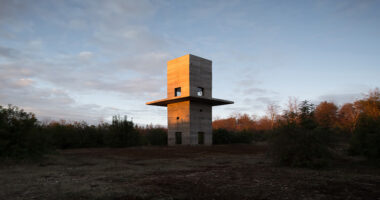Nestled along the picturesque south bank of the Qiantang River in Hangzhou’s Binjiang District, the Changting Station stands as a modern interpretation of ancient hospitality. As part of the extensive waterfront public space renovation project, this architectural marvel, crafted by the TJAD Original Design Studio, seamlessly blends tradition with innovation, offering a respite for weary travelers and leisure seekers alike.
A Legacy of Hospitality
Echoing the age-old tradition of rest stops along ancient roads, the Changting Station pays homage to its historical roots while embracing contemporary design principles. With a service radius extending 500 meters and over ten stations within its ambit, this project aims to create a comprehensive riverside waterfront service system, complete with rest areas, toilets, and commercial spaces. It redefines the concept of urban public spaces, transforming them into vibrant hubs of activity and community engagement.

Embracing the River’s Majesty
Unlike previous waterfront projects, the Changting Station confronts the challenge of a wide river and a vast spatial scale. Traditional approaches fall short in meeting the demands of such expansive landscapes. In response, the design team leverages the space under the eaves to create a semi-outdoor urban oasis—a sanctuary where visitors can immerse themselves in the tranquil beauty of the river. By maximizing every inch of available space, the station unfolds like a mesmerizing scroll, inviting exploration and contemplation.

Harmonizing Tradition and Modernity
Situated in the heart of the Xixing Ancient Town, the Changting Station pays homage to its surroundings while embracing modern architectural sensibilities. Clad in a two-story steel-wood structure, the station exudes an air of elegance and sophistication. Its meticulously crafted interiors, adorned with cultural displays and tea rooms, serve as a testament to the region’s rich heritage. Meanwhile, the surrounding landscape, adorned with golden-leaf metasequoia and pennisetum, adds a touch of natural splendor to the urban setting.

Bridging Past and Present
At its core, the Changting Station embodies the essence of architectural harmony. From its slender wooden beams to its robust rammed earth foundation, every element of the structure reflects a delicate balance of strength and grace. The seamless integration of traditional materials with modern construction techniques not only enhances the station’s structural integrity but also evokes a sense of timeless beauty. As visitors traverse its linear indoor and outdoor spaces, they embark on a journey through history—a testament to the enduring legacy of Hangzhou’s cultural heritage.

Conclusion: A Haven of Tranquility
In conclusion, the Changting Station stands as a beacon of architectural ingenuity and cultural reverence. By honoring the past while embracing the future, it transcends its role as a mere rest stop to become a symbol of community, connectivity, and contemplation. As travelers and locals alike converge upon its welcoming embrace, they are reminded of the timeless allure of Hangzhou’s riverside landscape—a testament to the enduring legacy of tradition and innovation.























